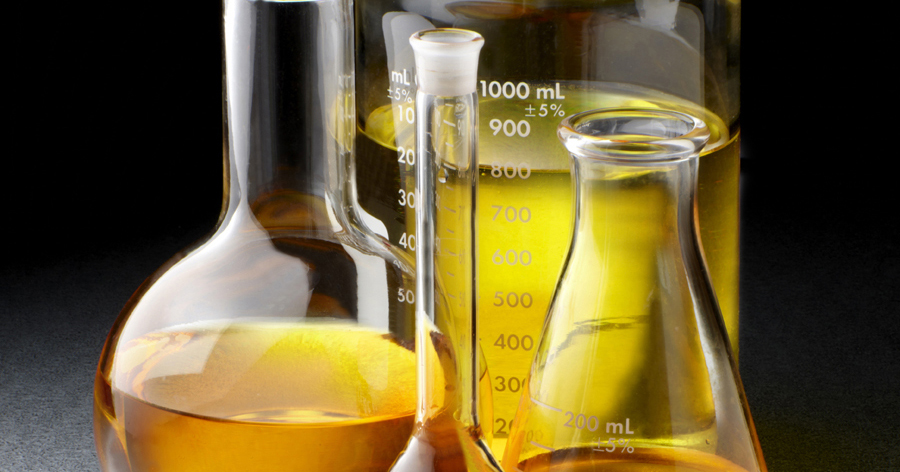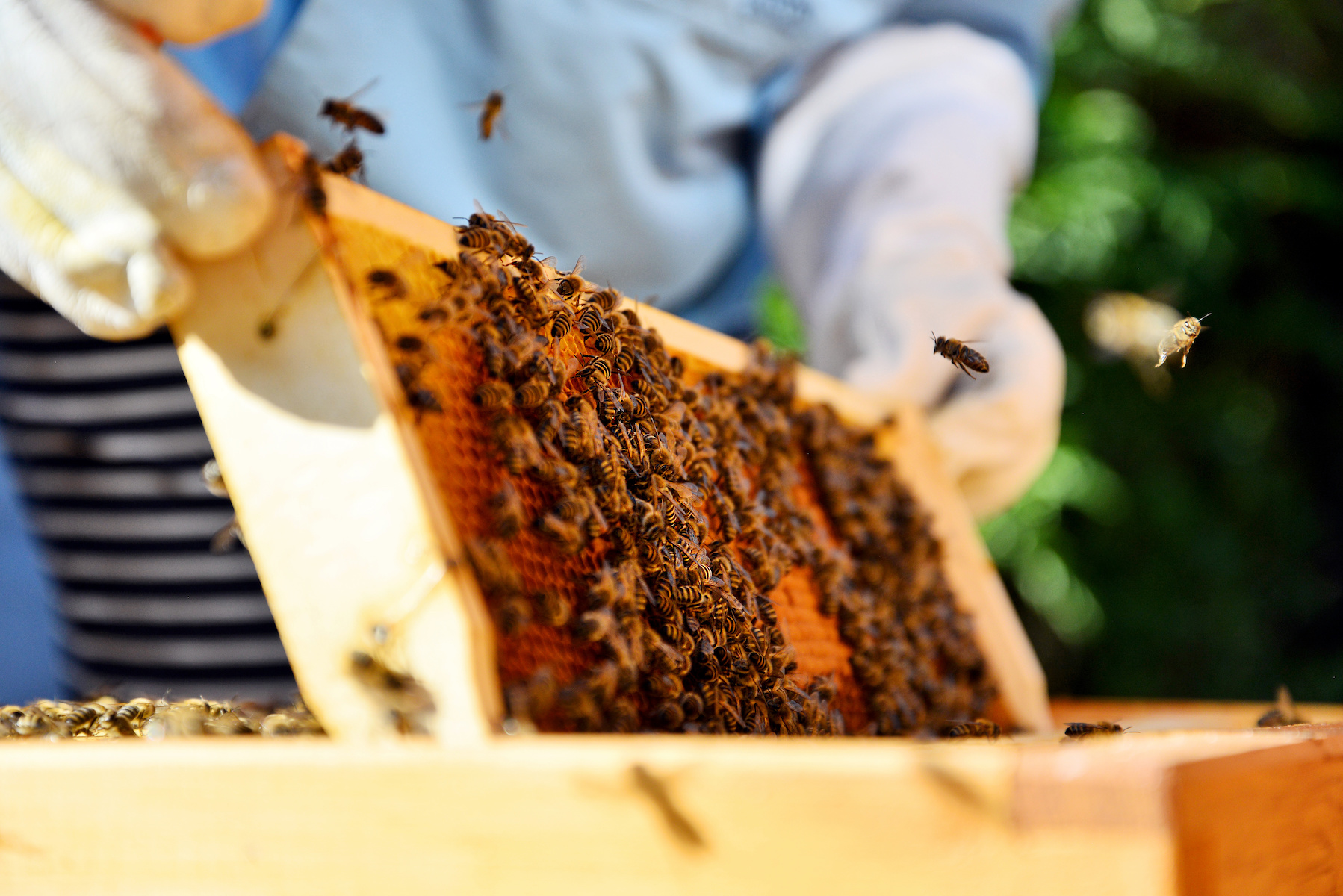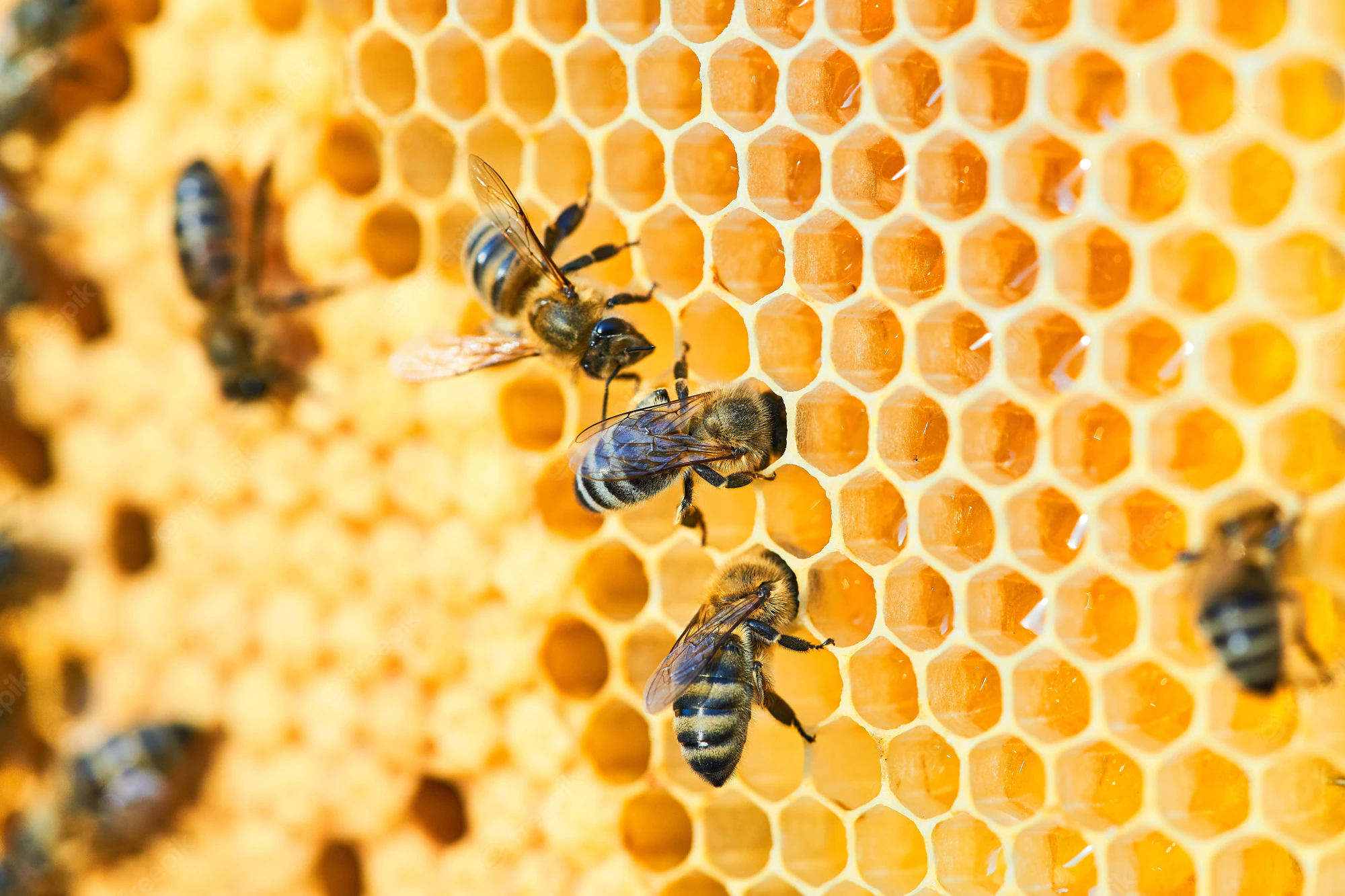Ever wondered what’s in your jar of honey? While the ingredient list on your label might just say “honey”, honey itself is made up of a myriad of chemicals and compounds that make it look, taste, and smell the way it does! Honey contains sugars, amino acids, proteins, minerals, and acids that together, make up that golden goo we love so much.
Carbohydrates
The most abundant class of compounds in honey are carbohydrates, which includes familiar compounds such as sugars, fibers, and starches. Chemically, a carbohydrate is a molecule with the general formula Cx(H2O)y, or a derivative of such. Sugars make up over 75% of honey, primarily in the forms of fructose and glucose. Fructose and glucose have the same chemical formula, C6(H2O)6, however, the way in which these atoms are arranged and connected to each other are different, giving each molecule its own set of unique characteristics. Picture two building blocks, one square and one rectangle – even though they are both made of the same material (for instance, plastic), they have their own unique shape that makes them unique. On their own, fructose and glucose are what is known as monosaccharides – when two of these molecules are joined together, they are called a disaccharide, and when three or more of these molecules are joined together they are called an oligosaccharide. Referring back to the plastic blocks mentioned earlier, consider the different combinations you could make if you had more than one of each block – you could put two squares together, or a square and a rectangle, or two squares and a rectangle – the possibilities go on and on. About 5% of honey is made of up of these disaccharides and oligosaccharides which include sucrose (a glucose and fructose molecules bound together), maltose (two glucose molecules bound together), turanose (a derivative of sucrose), and erlose (two glucose molecules and a fructose molecule bound together).
Minerals
While a variety of minerals can be found in honey, the overall mineral content is very small (01 – 0.3 %). Of this small amount, the most abundant mineral found in honey is potassium, the mineral many of us associate with bananas. Comparatively, 100 g of honey has around 15 % the amount of potassium in 100 g of banana. Other minerals are also found in honey, albeit in very, very small amounts; these are referred to as “trace elements”. Some studies have been able differentiate between honey collected from different floral sources based on the trace elements present.
Proteins and amino acids
Honey contains small amounts of proteins and amino acids, between 0.2 and 0.4 %. Amino acids are the building blocks from which proteins are made. There are 20 standard amino acids, 11 of which the human body is capable of synthesizing, while the other 9 (referred to as essential amino acids) must come from dietary intake. Most often, we get our essential amino acids from foods such as meat, dairy, soy, quinoa and buckwheat. The main amino acid in honey is proline, which is one of the amino acids the human body is able to produce on its own. The proline content of normal honey should be greater than 200 mg/kg, honey containing less than this amount is likely to have been diluted by adulteration with sugar syrups.
The main proteins in honey are enzymes. Enzymes are special proteins produced and used by the bees to aid in the chemical reactions necessary to convert nectar into honey. Enzymes typically have the suffix “-ase” at the end of their name. Diastase converts starch into maltose, invertase converts sucrose into glucose and fructose, glucose oxidase and glucose catalase regulate the production of H2O2 (hydrogen peroxide), which is one of the chemicals that gives honey its antibacterial properties, as well as gluconic acid, which plays an important role in honey taste.
Acids
Like many of the foods we eat, honey is acidic, meaning it has a pH value of less than 7. Common acidic foods include lemon, limes, oranges, pineapples and grapefruits, as well as plums, blueberries, tomatoes, and peaches! Honey typically has a pH of around 3.5 – 4.5, which is similar to the pH of foods like apples, blackberries, tomatoes/ketchup, and pears. The main acid present in honey is gluconic acid (which is produced from glucose), although it is present in a form that does not contribute to the acidity of honey. Minor amounts of other acids have been found in honey, including, succinic acid, acetic acid, citric acid, lactic acid, maleic acid, malic acid, oxalic acid, pyroglutamic acid and formic acid – which are common acids found in many foods.
Phenolics
Phenolic compounds are a class of aromatic compounds, which, you guessed it: are responsible for aromas! Phenolic acids are produced by plants and can end up in honey, and may have some uses in determining the floral source of unifloral honeys.
Microorganisms
Yes, that’s right, honey contains small amounts of bacteria and yeast! Luckily, since honey is what is known as a “supersaturated” solution it is impossible for the bacteria to grow – it just sort of “sits” there. In most cases, the bacteria in honey poses no threat to human health, but have you ever read the label of a honey jar and noticed that it says “do not feed to infants under one year of age?” Bacteria is the reason for that warning, or more specifically, the presence of spores produced by a specific species of bacteria: Clostridium botulinum. Not all honey contains these spores, but as honey is a natural product, it is not possible to control whether or not these spores are introduced into the honey. Most, if not all, natural products contain some small amount of these spores, and most of the time, they are of no danger to human health. While honey may contain these spores (which are not dangerous), it does not contain the botulinum toxin (which is dangerous) – however it is theoretically possible that the spores can release the toxin after being consumed by infants under one year of age. This may cause the infant to develop infant botulism, which is a serious illness that (fortunately) has low mortality. In most (but not all) cases of infant botulism in Europe, the infants had been given honey, but not all infants that were given honey developed infant botulinum. As a precaution, it is not recommended that infants under one year of age are given honey – hence the label.
Yeast is also present in honey and is not a threat to human health. The main concern with yeast is fermentation, which can cause changes to the look, smell and taste of honey that may make it unappetizing. Fermentation depends on moisture content, with higher levels of moisture posing a greater risk for fermentation. On average, honey has a moisture content of 17.2 %, but can range from 15 – 20 %. Generally, your jar of honey is safe from fermentation if it has a moisture content less then 18 %. As the moisture content increases to 19 or 20 %, risk of fermentation increases, as it may require as few as 1 – 10 yeast cells present in 1 gram of honey. If the moisture content of your honey is greater than 20 %, your honey is almost certain to undergo fermentation. Of course, there are cases in which you may want your honey to ferment – such as when making fermented honey or mead.
Why we care
The chemical composition of honey can be influenced by adulteration, such as the addition of sugar syrups. Sugar syrups contain different compounds than true honey. Rice syrup, a common honey substitute/additive in adulterated honey contains glucose, maltose and maltotriose. These sugars can be detected by chemical analysis and can help identify adulterated honey. If a sample of honey is found to contain unusually high amounts of maltose, it becomes suspect of adulteration. The ratios of the chemicals found in honey can also help to distinguish between pure and adulterated honey. Corn syrup is another common adulterant of honey, and is composed primarily of glucose. A sample of honey that has a glucose to fructose ratio that is higher than expected may be the product of adulteration. Moisture content may also hint towards adulteration, as some adulteration methods include the addition of sugar-water to honey.
Different floral sources can influence the chemical composition of honey such as manuka honey containing MGO and DHA. Knowing the correct chemical composition of each floral source for honey is useful for adulteration detection and to ensure that customers are getting what they paid for. If you buy a jar of blueberry honey, you would want it to be blueberry honey – not a blend of blueberry and raspberry honey, or even worse, not contain any blueberry honey at all!
Various techniques have been used to analyze the composition of honey, such as mass spectroscopy (MS), infrared spectroscopy (IR) and nuclear magnetic resonance spectroscopy (NMR). At True Honey Buzz, we are fascinated by the differences seen in the “chemical fingerprints” of honey by our NMR machine based on the honeys floral source. We have even discovered unique peaks (part of the “fingerprint”) in our BC blueberry honey that allow us to distinguish it from others. To learn more about True Honey Buzz and out research using NMR, visit our website truehoney.buzz.




Leave A Comment